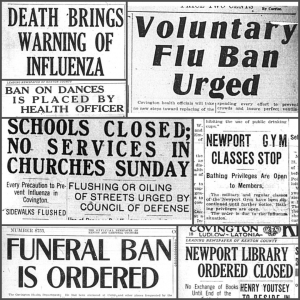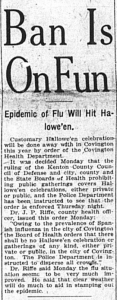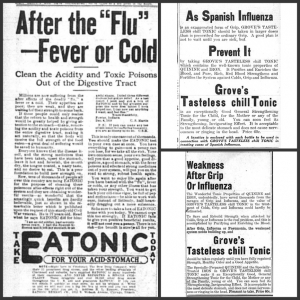We are creeping into that time of the year again: autumn. Autumn is all kinds of fun: pumpkin-flavored everything, apple cider, trick-or-treating, and a crisp, cool air that we are always pining for following the dog days of summer. Cool weather shoos us inside more often than summer, however, and germs are more easily spread in close proximity to others. Cue flu season, that nasty fact of life that persists from roughly October to March. Ninety-eight years ago this month, the country at large was experiencing one of the most severe outbreaks of flu in its history. Cue the constant hand-washing, and stock up on hand sanitizer, because we are about to venture into a brief, local history of the Spanish Flu Pandemic of 1918-1919.
Influenza comes with a slew of uncomfortable symptoms that we also associate with the common cold, but multiplied in intensity. Influenza can be life threatening to those with comprised immune systems such as the elderly and very young. Between three to five million severe cases of influenza occur each year throughout the world, with death tolls from the flu, or complications from it, ranging from 250,000 to 500,000 worldwide (1). Some years, however, the primary strain of influenza is particularly virulent and panic-inducing: for example, the Swine Flu Pandemic of 2009. The fall of 1918 happened to bring with it one of those flu strains, and was quite possibly the largest outbreak of disease in the 20th century United States.
Panic Ensues
The Public Health Service began requiring states to report cases of flu starting on September 27, 1918, coincidentally the date that influenza is estimated to have arrived in the state of Kentucky (2). The first newspaper reported death from influenza was that of Harry Lewis Wilcox, a 22 year-old sailor from Ludlow, KY who died on September 23, 1918 at Naval Hospital Great Lakes in Illinois (Kentucky Times Star, 26 Sept. 1918). Just a day later, the death of Joseph Schulkins, a 27-year old from Newport, was reported. Schulkins died within 24 hours of exhibiting symptoms of influenza, and was described as “one of the most robust men in Newport” (Kentucky Post, 27 Sept. 1918).
A Plea for Help
Immediately after the onslaught of Spanish Influenza, the Red Cross made efforts to recruit nurses to aid in the epidemic (Kentucky Times Star, 5 Oct. 1918). Given the virulence and transmissibility of the virus, nurses must have been in short supply. Public health officials and physicians were urged to report cases of the disease to James L. Fleser, the division director of Civilian Relief, as well as to report on the number of beds available in hospitals within their jurisdiction, and how many other buildings available to serve as makeshift hospitals if necessary (Kentucky Times Star, 5 Oct. 1918).
Containing the Illness
Almost immediately after the arrival of flu, efforts were made to educate the public on how to prevent the spread of the virus. A number of bans went into effect throughout Northern Kentucky to combat the spread of influenza. Public funerals were forbidden for persons who died of influenza (Kentucky Times Star, 7 Oct. 1918; Kentucky Post, 7 Oct. 1918; Kentucky Post, 10 Dec. 1918), and no caskets containing victims of flu were to be opened for memorial service (Kentucky Times Star, 7 Oct. 1918). In Fort Thomas, public meetings were forbidden in an attempt to combat the spread of flu (Kentucky Times Star, 5 Oct. 1918).
Street cars and theaters were ordered to be fumigated by the Covington Board of Health (Kentucky Times Star, 2 Oct. 1918). The Council of Defense ordered the cleaning of Kenton County streets by “flushing or oiling,” (Kentucky Times Star, 7 Oct. 1918). Similarly, flushing of the streets by fire house was urged on October 17 – Major John J. Craig stated that the fire hoses had gotten more use in two weeks than they had in the previous two years (Kentucky Post, 17 Oct. 1918). Officials also advocated the use of paper or paraffin cups in places of public drinking (Kentucky Times Star, 7 Oct. 1918).
Ban on Fun & Daily Activities
By October 9, Covington was estimated to have 1,000 cases of influenza (Kentucky Times Star, 9 Oct. 1918). Citizens were urged to avoid crowds at all costs (Kentucky Times Star, 7 Oct. 1918) and wear masks each and every day to prevent the spread of influenza (Kentucky Times Star, 19 Oct. 1918). Establishments in Northern Kentucky saw the effects of the bans ordered. Announcements blared on the front pages of the newspapers, and served as daily reminders that people should not venture out unless necessary.
Initially, most events and meeting places that could draw a crowd were cancelled or closed – baseball games, saloons, billiard rooms, and community meetings (Kentucky Post, 7 Oct. 1918; 8 Oct. 1918). Schools and churches were some of the first establishments to close, and remained closed for weeks on end. On October 5, 1918, the Kentucky Post headline read “Ft. Thomas Shuts Schools, Churches and Theaters in Fight on Influenza”; similarly, children under the age of 18 were not permitted to ride the street car, nor were the soldiers stationed at Fort Thomas. Two days later Kenton County officials followed suit and cancelled church services, an announcement that arrived late, leaving churchgoers greeting locked doors that Sunday morning (Kentucky Post, 7 Oct. 1918).
As the days crept by, the rules became a bit less restrictive but still erred on the side of caution. Classes at the Newport Gym were discontinued for both men of the military and members of the community amidst the outbreak, though the baths remained open (Kentucky Post, 8 Oct. 1918). Ice cream parlors, saloons, and soda fountains were ordered to reduce hours and avoid staying open in the evening hours (Kentucky Times Star 19 Oct. 1918). Dances in Covington were forbidden as late as December (Kentucky Times Star, 10 Dec. 1918), and the Newport Library was also ordered to close and discontinue the circulation of books until the influenza epidemic had passed (Kentucky Times Star, 13 Dec. 1918). Even trials were postponed due to illness on a number of occasions (Kentucky Post, 7 Oct. 1918; Kentucky Post 10 Dec. 1918).
It should come as no surprise that even holidays were affected by the influenza outbreak. Halloween was a grim time for residents of Covington – the annual celebration was cancelled amidst the outbreak, with both public and private affairs strictly forbidden (Kentucky Post, 28 Oct. 1918).
Snake Oil
In an attempt to profit from the ill-fortune of those inflicted with influenza, advertisements were put posted in the newspaper for products promising good health if taken after a bout of the flu. “Eatonic” (Cincinnati Times Star, 27 Dec. 1918) and “Grove’s Tasteless chill Tonic” (Kentucky Post, 22 Oct. 1918; 18 Nov. 1918) were just two of the products touting the promise of a full recovery, or preventative properties to help one avoid the flu altogether.
Looking Up
Public health bulletins were printed every several days, reminding people of the dangers of flu and how to go about avoiding it. Announcements for the deaths of revered community members could be found in the newspaper almost daily, whether it was a beloved teacher, military man, or prominent member of society – no one was immune from influenza. Updates on the death toll served as grim reminders that the disease was far from gone, though officials weighed in to state whether the epidemic was on the rise or waning. Come December, the headline “Situation Not Half as Bad as During October,” (Kentucky Times Star, 5 Dec. 1918), a statement directly from James P. Riffe, Covington’s health officer, offered hope that influenza was on the wane. The death toll in Covington as of late November was at 157, while Newport had 30 deaths from the flu (Kentucky Post, 18 Nov. 1918).
The bans on activities became less restricting, and eventually establishments resumed normal operations. Covington lifted its ban on children attending church on December 19, 1918 – though they were still forbidden to visit a number of other establishments (Kentucky Post 19 Dec. 1918). On December 23, 1918, Dr. Riffe stated that new cases were on a steady decline and that churches, schools, and theaters may again resume operation – while exercising a bit of caution, of course (Kentucky Post, 23 Dec. 1918).
The epidemic remained steady in the final days of 1918; roughly 8,000 individuals had already succumbed to the ailment in Kentucky (Kentucky Times Star, 27 Dec. 1918). The Red Cross made another plea to recruit individuals to work army camps and communities in December: “No Nurses in Covington to Attend Flu Victims” (Kentucky Post, 4 Dec. 1918).
Locally, the intensity of the epidemic can be seen in the St. Elizabeth Hospital Patient Records index (available on GenKY). Influenza cases grew from October through November of 1918, then generally declined thereafter, only to spike again in March of 1919. These cases don’t even reflect the related ailments influenza sometimes caused. It is certainly not uncommon for to look through death records from October through December of 1918 and see the cause of death listed as lobar pneumonia or bronchopneumonia, with influenza commonly listed as a contributory cause.
No modern influenza outbreak has quite matched that of the Spanish Influenza Pandemic of 1918-1919; recent estimates put the death toll between 50-100 million individuals (3). As we tread into the flu season of 2016, we can be thankful that most influenza seasons aren’t like 1918-1919. However, the Spanish Influenza Pandemic a grim reminder that we are but delicate creatures caught up in a global web of disease.
Looking for more information on the Spanish influenza outbreak of 1918-1918 in Northern Kentucky? Visit us for access to Kentucky Death Records from the period*, newspapers on microfilm*, or browse our database, GenKY, for the St. Elizabeth Patient Records index.
*Some resources may only available at the Covington location. Please call us at 859-962-4070 for details.
Sources Cited
- World Health Organization. March 2014. “Influenza (Seasonal).” Accessed August 31, 2016. http://www.who.int/mediacentre/factsheets/fs211/en/.
- United States Department of Health and Human Resources. N.d. “Great Pandemic: The United States in 1918-1919: Kentucky.” Accessed August 31, 2016. http://www.flu.gov/pandemic/history/1918/your_state/southeast/kentucky/index.html.
- Johnson NP, Mueller J. 2002. Updating the Accounts: Global Mortality of the 1918–1920 “Spanish” Influenza Pandemic. Bulletin of the History of Medicine 76:105–115.






Add a comment to: The Spanish Flu Pandemic of 1918-1919 in Northern Kentucky